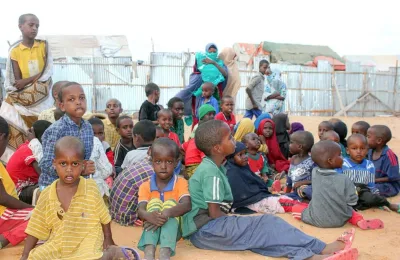This is a summary of what was said by UNHCR spokesperson William Spindler – to whom quoted text…
 This is a summary of what was said by UNHCR spokesperson William Spindler – to whom quoted text may be attributed – at the press briefing, on 17 October 2014, at the Palais des Nations in Geneva.
This is a summary of what was said by UNHCR spokesperson William Spindler – to whom quoted text may be attributed – at the press briefing, on 17 October 2014, at the Palais des Nations in Geneva.
There’s been a sharp increase this year in the number of migrants and asylum seekers losing their lives in attempts to get to Yemen, mainly from the Horn of Africa, with more deaths in 2014 than in the last three years combined
In the latest tragic incident on Oct 2, 64 migrants and three crew died when their vessel, sailing from Somalia, sank in the Gulf of Aden. With five additional deaths since, this brings the number of dead this year to 215, exceeding the combined total for 2011, 2012 and 2013. It’s also the largest single loss of life since sinkings in June, when 62 people died; March, when 44 people lost their lives; and another in April, with 12 people dead.
There have been frequent reports of mistreatment, abuse, rape and torture and the increasingly cruel measures being adopted by smuggling rings seem to account for the increase in deaths at sea. Boats crossing to Yemen are overcrowded, and smugglers have reportedly thrown passengers overboard to prevent capsizing or avoid detection. Search-and-rescue officials say the practice has resulted in hundreds of undocumented casualties in recent years
The latest deaths come against the background of a dramatic increase in the number of new arrivals for September off Yemen’s coast. At 12,768, it marks the single biggest month for arrivals since current records began to be kept in 2002.
The reasons for the surge are believed to include ongoing drought in South-Central Somalia, as well as the combined effects of conflict, insecurity, and lack of livelihood opportunities in countries of origin. Moreover, the surge can also be attributed to a decreasing level of cooperation between the countries in the region to better manage migratory movements.
UNHCR and its partners provide initial reception and assistance to individuals arriving across the Yemeni coast at the Red Sea and the Gulf of Aden as well as record all reported incidents. UNHCR and the Society for Humanitarian Solidary provide first aid, and food assistance at 3 coastal transit centers to those identified, usually in a dire situation, by the patrolling teams upon their arrival at the coast.
Transportation services are then provided from the transit centers to the nearest reception center for initial registration by the Danish Refugee Council (DRC) on behalf of UNHCR. With Somalis receiving prima facie refugee status from the Government of Yemen, non-Somalis who express interest in seeking asylum are provided with attestation letters to present at the UNHCR offices in Sana’a or Aden and begin the Refugee Status Determination process.
Despite the commitment and the continuing work of the Yemeni Government and others on this issue, it is clear that these ongoing efforts alone cannot hope to avoid such loss of life.
UNHCR has continued to offer support to the Government of Yemen in strengthening its capacity for search and rescue at sea, safe embarkation and proper identification, as well as initial reception and referral mechanisms for vulnerable people in need of protection and assistance.
We also call on countries of origin, transit and destination in the region to step up their cooperation in managing the flows of migration. At the same time they must pay due attention to the protection needs of refugees, asylum seekers and other vulnerable groups such as women and minors. This kind of regional cooperation was the central idea behind a Regional Conference on Asylum and Migration organized by the Government of Yemen with support from UNHCR and the International Organization for Migration in November 2013 and it lies at the heart of the Sana’a Declaration adopted by the Conference.
Yemen is the only country in the Arabian Peninsula that is signatory to the 1951 refugee Convention and its 1967 Protocol. It currently hosts 246,000 refugees of whom over 230,000 Somali and a smaller portion of Ethiopian, Eritrean, Iraqi and Syrian refugees. The majority of the refugees have been living in Yemen for many years. Yemen also hosts more than 334,000 Internally Displaced Persons, either forced from their homes as a result of recent conflicts or living in long-term displacement.
Source: UNHCR







